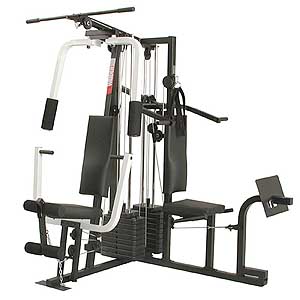
The main purpose of this article is to dispel any bad information that may have been placed in your mind by a "trainer" at the gym, or a mainstream muscle magazine. Circuit training has gained a reputation for being the end all be all of weight training despite a host of problems that this type of training brings with it. I would like to attempt to use this article to clear your mind and prepare you to consider my next article on heavy weight compound exercises. Weight machines have all of the following negative associations: unnatural movements, isolated muscle use (this can occasionally be used for benefit), increased risk for injury, very time consuming, builds very little real world strength, and machines do not promote stability or balance.
One of the main problems with machines, and isolated movements in general (especially for beginners), is that a machine forces your body to perform a lift while confined to the shape of the machine; it forces one muscle (say a bicep) to perform all of the work, and this forces your body into unnatural movements and ultimately leads to decreased synergy of muscle groups and even increased injury. In this scenario your body is taught to work as separate units as opposed to a singular unit. For example when trying to stand on one foot, if a person was trained extensively on machines this could be incredibly difficult, all the stabilizer muscles in the: legs, feet, lower back, and abdomen are used to working independently making it much more difficult for them to work together as a unit. Take this same person after several weeks of heavy squat training and you would find a stronger core, and stronger legs and feet, that are used to working as a unit to provide a much more stable base with much better balance. The functionality of using machines for weight lifting is severely limited, very few times (if ever), will your body ever have to work in exactly the same way as a machine forces you to work, however if you look at the majority of human movement one can see how often we are: bending over, squatting down, pushing or pulling something, or even lifting something over our heads, this is one of the main reasons I believe that heavy compound exercises offer much greater gains in measurable and real world strength. The strength gains on a squat will immediately be noticeable in everyday life, while a stronger preacher curl might never make a difference in your sport, or your day to day life.
Weight machines also have a much greater chance of injury due to forcing your body into unnatural movements. Take for example a front squat and compare it to a quad extension; a quad extension machine puts the load directly on your quadriceps and also directly on your knee joint which can wear down cartilage and damage your knee, where as a front squat spreads the weight over your lower back, abdomen, calves, quadriceps, and the hamstrings. Outside of the increased risk of injury directly from using machines are the residual effects of using weight machines like creating muscle imbalance. If you were to train more quadriceps than hamstring exercises then you will develop a weaker posterior chain which can increase risk of pulled/torn hamstrings and groin muscles, as well as injury to the lower back. Since machines isolate muscles they do not provide a realistic full range of motion, and since the use of machines translates very little into real world functionality they can actually lead to muscular imbalance and decreased balance and stability.
Another major misconception about circuit training with machines is that it is a more efficient way of training and takes less time to complete. Lets say you want to perform a total body workout and work each major muscle group with 3 sets of 8 repetitions; if you were to do a circuit workout you would need to do 3 sets each for: chest, biceps, triceps, lower back, abdomen, quadriceps, hamstrings, calves, forearms, deltoids, abductors, adductor, lats, and the rest of the upper and middle back. That could definitely be very time consuming, now lets look at a workout with only 4 exercises that would hit all of these same muscle groups using compound lifts: bench press, squat, bent over row, and planks. Using my current method I often complete a total body workout in about 45 minutes without being completely exhausted afterward, I usually go to BJJ class just an hour or two after finishing without being worn out.
These are just a few of reasons that I now choose to make about 99% of each workout consist of compound dumbbell, barbell, and body weight exercises. My next article on weightlifting will cover starting out for a new lifter, and give some tips on how to create a solid and functional strength base that will help a new lifter become: stronger, leaner, more stable and balanced, and also more powerful.
I'd like to thank my readers and encourage everyone to please either subscribe to my RSS feed, sign up for email updates, or add me on Facebook if you haven't already. I am constantly looking to add traffic to my blog to help it grow, so If you like what you are reading simply click in the upper right corner of my page to share my page or this post on many different platforms including: Facebook, Digg, and Stumble Upon.






0 comments:
Post a Comment